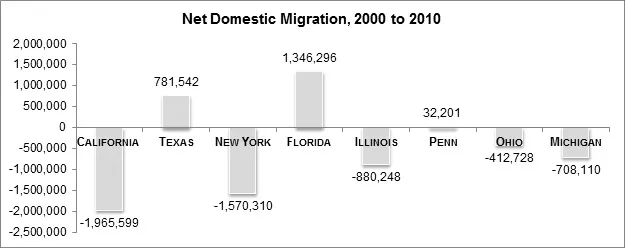Seven Top-Ranking States For Cost of Living-Adjusted Disposable Income in 2012 All Have Right to Work Laws

Tell Albany: It’s Time to Raise New York’s Minimum Wage | Raise …
Cost of Living 4th Quarter 2012

If Big Labor propaganda regarding comparative living standards in forced-unionism and Right to Work states were correct, surely more people would be moving into union strongholds like California, New York, and Illinois than are moving out of them. But that's far from the case. Image: Daily Caller, drawing on U.S. Census Bureau data
During their successful push early this year for a minimum wage hike in the Empire State, Big Labor and its allies repeatedly invoked New York’s extraordinarily high cost of living as a reason for why its minimum wage should be substantially higher than the national minimum.
For example, one fact sheet released by the union front group “Raise the Minimum Wage” (see the first link above) emphatically stated:
A full-time minimum wage earner in New York brings home just $15,080 per year — not nearly enough to make ends meet given the state’s high cost of living.
But the same union officials who understand full well that compulsory-unionism states like New York, New Jersey and California are far more expensive than the national average when they are pushing for minimum wage increases in such states can forget entirely about regional disparities in cost of living when they are attacking Right to Work laws.
Many statistics regarding incomes in Right Work and forced-unionism states cited by Big Labor propagandists ignore regional cost-of-living differences completely. Others rely heavily on regional cost of living indices created by the forced-unionism funded Economic Policy Institute (EPI) that show forced-unionism strongholds like New York and New Jersey as having a cost of living far closer to the national average than do nonpartisan researchers who have no ax to grind. Moreover, the EPI does not publicly disclose just how it calculates interstate cost of living differences.
Unlike the EPI, the Missouri Economic Research and Information Center (MERIC) relies on the highly respected Council for Community and Economic Research (C2ER) for the raw data it uses to calculate the relative cost of living in each of the 50 states. C2ER’s metropolitan-area cost-of-living data have been cited by the U.S. Commerce Department’s Statistical Abstract and an array of other standard references. EPI’s cost-of-living data are cited almost exclusively by partisans of compulsory unionism.
This week, the National Institute for Labor Relations Research adjusted 2012 disposable income in the 50 states as reported by the Commerce Department (see the second link above) for cost of living by using an average of MERIC’s four quarterly cost-of-living indices for 2012 (indices for the fourth quarter are available in the third link).
The Institute found that the average cost of living-adjusted disposable income per capita in Right to Work states last year was$37,665, nearly $2300 higher than the forced-unionism state average. All seven of the top-ranking states (Iowa, Kansas, Nebraska, North Dakota, Texas, Virginia and Wyoming) have Right to Work laws on the books. Seven of the eight bottom-ranking states (Alaska, California, Hawaii, Maine, Oregon, Rhode Island and Vermont) lack Right to Work laws. The sole exception in the bottom eight is Right to Work Arizona.
The strong correlation between Right to Work status and higher cost of living-adjusted disposable income does not in itself prove that Right to Work laws cause incomes to rise, but it strongly tends to disprove loud assertions by union propagandists that compulsory unionism is good for workers’ pocketbooks.

